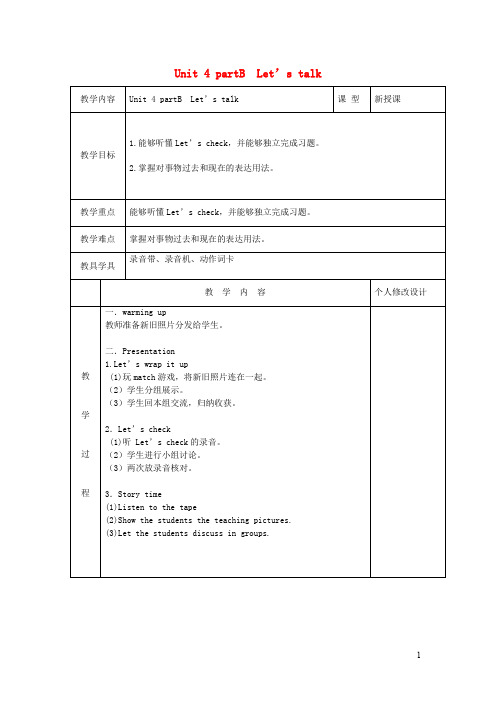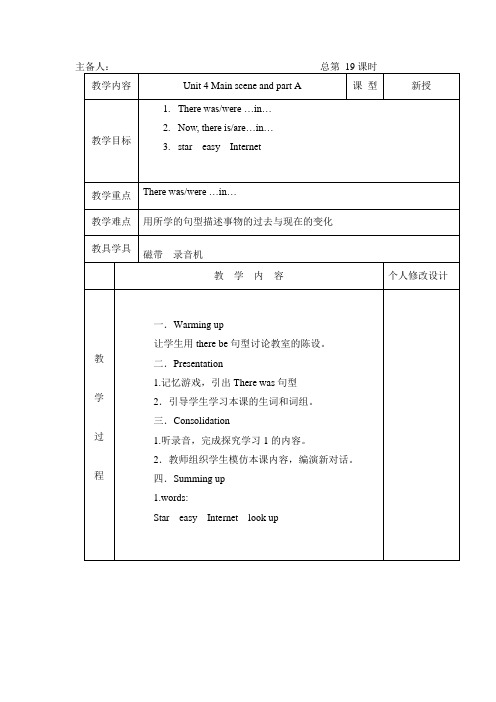【教案】人教版英语六年级下册Unit 4 第三课时
- 格式:doc
- 大小:61.50 KB
- 文档页数:7

新人教版六年级英语下册Unit4教案学科英语年级六年级单元第四单元课型课题Thenandnow课时安排1课时主备教师备课时复备教师班级授课时间间1听说认读单词:dininghall,gym,gra,yearago,monthago,latyear, latmonth.教学目2学习句型:Therewa/wereWedidn’thave及其一般过去时态的具体运用。
标学生会根据具体年代判断与之相符的事物。
学唱歌曲《Changeinme》教学重过去时间状语的运用。
点教学难句型Therewa/were的具体运用点教法学教学用具法教学过程复备内容Step1.预习温故GooverthephraeofUnit3:atefrehfood,wentwimming,took picture,boughtgift,rodeahore,rodeabike,wentcamping,hurtmy foot,wentfihing教师说短语的第一个单词,学生说出短语,并造一个句子。
如T:took.S:Tookpicture,Itookpicturelatweekend.(边做动作边说)2.Freetalk.T:HowwayourweekendS:Itwafine.T:Wheredidyougo、S:Iwentto...T:HowdidyougothereS:By...T:WhatdidyoudothereS:Iwentfihing./...Step2.新课内容展示1教学单词dininghall,gra,gym,ago.(1)Showthepictureofgra.T:What’thiS:It’gra.板书gra并教读。
Chant:Gra,gra.Playfootballonthegra.以同样的方法教学dininghall,gym.Chant:Dininghall,dininghall.Havelunchinthedinning.Gym,gym.Playbaketballinthegym.(2)教学单词ago及词组...yearago,...monthago.教师先说几个句子让学生感受。



六年级下册英语教案-Unit 4 Free Time Lesson 3 人教新起点版教材内容分析本课教材主要涉及到口语、听力、阅读、写作四个方面的训练。
教材内容分为两个部分,第一部分是示范对话,主要让学生学习如何询问和回答自己的爱好。
其中,“What do you like doing in your free time?”是本课的主题句,学生需要理解和掌握这个句型,以便能够在日常生活中运用。
第二部分是阅读短文,内容涉及到三个孩子的爱好,并且通过对短文的理解,学生要在作业本中完成一些对短文的相关问题的练习。
教学目标知识目标1.理解并掌握询问和回答自己爱好的句型“What do you like doing in your free time?”。
2.理解文中所涉及的词汇和短语,如watch TV、play basketball、read books等,并能够将其运用到实际生活中。
3.理解短文中所描述的孩子的爱好,并能够从中抽象出表达自己爱好的模式。
能力目标1.通过听、说、读、写四种方式,加深对语言知识的理解和记忆。
2.培养学生运用语言进行交流的能力。
3.培养学生主动使用语言技能的意识和独立思考能力。
情感目标1.培养学生爱好运动和阅读的兴趣和习惯。
2.培养学生良好的合作和竞争的精神。
教学重点1.理解并掌握询问和回答自己爱好的句型“What do you like doing in your free time?”。
2.通过短文中的阅读,了解不同孩子的爱好模式。
教学难点理解文本中所包含的细节和情感,因为这是口语表达和写作的基础。
教学方法1.任务型教学法。
2.多媒体辅助教学法。
3.小组合作学习法。
4.交际法。
教学准备1.PPT课件。
2.练习册和作业本。
3.卡片和海报。
4.多媒体设备。
教学过程Step 1:Warming upT:Hello, class. Today we are going to learn Unit 4 Free Time Lesson 3. Let’s start with some warm-up activities. (播放课件,让学生自己说出自己的爱好,使用What do you like doing in your free time?这个句型)Step 2:Pre-task activityT:Now let’s do a pre-task activity. I will give you some pictures and ask you to work with your partner to make a poster about your favorite activity. (学生在海报上画出他们最喜欢的活动。

Recycle Mike’s happy days单元整体分析本单元是人教版英语六年级下册的总复习单元,单元的话题是“Mike’s happy days”。
本单元通过Mike参观农场的七天之旅以及参加毕业典礼晚会的语境把已经学过的语言知识有机地融合在一起,并通过不同类型的任务,帮助学生复习巩固语言形式,培养综合语言运用能力以及自主学习能力。
共八个教学内容,分四个课时完成。
第一课时包括Day1和Day2两个部分, Day1呈现了Mike来到农场并参观农场的场景,通过Mike在农场看到水果、动物等场景复习已学过的名词及其与冠词的搭配。
Day2呈现了两个场景。
一个是Mike在农场里认识了新朋友Bill和他的妈妈Mrs Booth, 另一个是Bill打算和妈妈购物。
通过这两个场景复习描述人物外貌的词汇、句子以及与购物相关的词句。
第二课时包括Day3和Day4两个部分,Day3部分通过人们在农场生活的场景,复习巩固学过的动词短语以及一般现在时和现在进行时的结构。
Day4部分,呈现了两个场景。
一个是描述Mike一天的农场生活,另一个是Bill和Mike玩卡片游戏。
通过这两个情景复习巩固一般过去时和形容词比较级的用法。
第四课时包括Day5和Day 6两个部分,Day5通过Mike介绍自己周一上课的情况,复习一般现在时和科目名称。
Day 6通过描述Bill从小时候到现在的变化以及对未来的预测,复习一般过去式、一般现在时和一般将来时的用法。
第五课时包括Day7, Day8 , Read the chant和Story time三个内容,Day7通过Mike收到学校的毕业典礼晚会邀请函作为语境,引出一般将来时。
Day8通过毕业晚会、歌谣、临别赠言三个场景,复习所学餐具、食物、文具等词汇以及元音、辅音字母组合的发音规律。
本单元的重点是复习所学的词汇、句子和四种时态。
本单元是总复习单元,是由一个整体语境构成。
在教学中,首先要让学生建构整体框架,基于整体情景建构文字意义,再进入各部分教学。

第一课时课时内容A Let’s learn Find the mistakes课时分析本课时是人教版六年级下册第四单元第一课时。
围绕“学校新旧的变化”这一话题展开,主要通过对话学习三个学校设施名称和几个表示过去的时间短语:dining hall, gym, grass, ... years ago, ... moths ago, last year/month及句型There was... There is...的表达。
引导学生了解周围事物的变化,渗透中国的历史文化的学习,同时保持学习英语的兴趣,激发学生学习英语的热情以及树立学习英语的信心。
第一课时是本单元的基础课时,要让学生重点把握知识,为学习其他课时打下良好的基础。
本课时的的重点是四会单词、短语的掌握以及能够运用四会单词和短语描述某个地方的过去和现在。
本课时包括Let’s learn 和Find the mistakes两个板块。
Let’s learn呈现了吴一凡学校的图片,通过图片体现单词dining hall, gym, grass的词义。
此板块呈现的对话情境是吴一凡的爸爸和吴一凡谈论学校的变化,从而引出句型There was/ is...学校是学生上学的地方,学生在成长的过程中,待的时间最长的地方就是学校。
“学校”的话题,符合学生的心理,很能引起学生的共鸣。
Find the mistake 板块是一个综合性的语用活动。
可以通过这个活动训练学生本节课学习的单词、短语进行表达,又训练学生的观察力并渗透中国历史文化知识的学习。
本课时虽然是新授课,但是词汇、对话比较简单,容易理解和接受,在设计教学过程时,增加一些词汇量at that time, in the old time(days)等,让学生课前收集一些和本课有关的资料,拓展文本,重在应用。
采用的教学方法有任务型教学法、合作探究法、愉快教学法等。
课时目标(1)能够听、说、读、写单词和时间短语:dining hall, gym, grass, ... years ago, ... moths ago, last year/month(2)能够恰当运用上述单词描述某个地方的过去和现在。
第三课时教学目标1.能够听懂、读懂句子:We are all different now! I was short, so I couldn't ride my bike well. Now, I go cycling every day.2.能够完成Let's try部分的听力练习。
3.能够听懂、读懂对话,并进行角色表演。
4.能够根据提示,描述自己外貌、喜好等的变化。
教学重点1.会用一般过去时态描述朋友和家庭成员的变化,同时正确运用一般现在时态。
2.正确使用助动词did和系动词was, were。
教学难点能够根据提示,描述自己外貌、喜好等的变化。
教学准备教师准备:1.与本课时相关的单词卡片和教学挂图。
2.本课时的录音和课件。
3.教师个人旧照片。
学生准备:1.自己以前的照片。
2.白纸。
教学方法1.听说领先法教师播放Let's try 和Let's talk 部分的对话录音,学生大声跟读,然后朗读。
不断提高学生的朗读水平。
2.角色表演教学法学生根据Let's talk 中的对话,进行分角色朗读,在训练学生口语的同时,通过以前和现在的对比,让学生在时间上有个过去的概念,从而加深对一般过去时的了解。
教学过程Step 1: Warm-up1.教师播放本单元歌曲Changes in me,师生一起欣赏。
学生尝试找出里面的比较级单词,理解意思后,教师再次播放录音,师生一起跟唱。
2.说说我的变化听完歌曲,学生尝试说说“我”的变化,教师出示下面的表格,学生根据表格提示,说句子。
如:Before,I was…Now,I'm…教师可先举例子:Before I was short. Now I'm tall. Before I was quiet. Now I'm active.学生模仿教师的例子来说句子。
3.教师出示自己的旧照片,说:This is my old photo. Look, I had short hair. But now I have long hair.接着再出示另一张骑自行车的照片,说:I couldn't ride my bike then. But now I go cycling every day.教师板书短语:go cycling并领读。
Unit4 Then and Now一.教学目标:1.听说读单词e-book, mobile phone, newspaper, radio, telephone, e-friend, anywhere, could,并能运用于语句中。
2.掌握动词过去式的发音及用法,会说…could/ could not…3.通过过去和现在的对比,感受个人的成长和社会的进步。
二.教学过程Step 1. Warming up1.T: Do you know the song?S: Where is time going?T: Yes, time flies quickly. We are growing up, and the things around us are changing. We know, the world is changing.2. T: Then what is changing? Do you have your idea?Step1. New learningA.1. T: Perfect. I like your ideas. Now I’ll show you a family. Do you know them? Who is he/ she? ( Mike, Mr Brown, Mrs Brown, Mike’s grandpa)2. Look, guess and matchWatch the cartoon and check the answerT: (总结)The time before, we can use this word: Then. ( what does it mean?)T: Today, we are going to learn Unit 4, Then and now.(读题目,学生用自己的理解去翻译题目T: Not bad. Good idea. I like it…)T: SO ,can you say sth. about Mike’s family? (对比说,is/are, was/were)T: They have changed a lot. And this lesson, we’ll know more about the changes of Mike’s family.B.1. (图) This boy, he is Mike. Now, he is a young boy. And he can do many things now. Let’s guess, what can he do?(图)T: Could Mike do all these things six years ago? What could he do? (读could)I give you two fist letters here. Can you guess? What couldn’t he do?T: So, six years ago, Mike could read….. but he …(师生一起读文本)T: Can you describe little Mike six years ago and young Mike now?总结:In fact, everyone is changing everyday( the changes of people), What they look like is changing(appearance) , and what they can do is changing, too(ability).3. T: And we know, as we people are changing everyday, our life is changing, too.Look and say. What are they? telephone, letters, email, mobile phoneWhat do you like? Why?4. look at Mr Brown. This is Mr Brown twenty years ago. And This is Mr Brown now. What did he do then and what does he do now?(1)Read the paragraph quickly, What did he use twenty years ago? Where did he……? (match: wrote letters, used the telephone)How about now? ( match: writes e-mails, uses the mobile phone)anywhere anytime anyone(总结)T: Then and now, the way to contact people is changing .5. T: look at the pictures, do you remember her? —Mrs Brown Let’s se e what changes have happened on her.What did Mrs Brown do?……Where did she make friends? And where did she buy things?Learn Passage 4 and try to ask and answer in pairs.(总结:It tells us the way to ______ and the way to _______. And the ways are changing now.)6. (1)T: And besides these, the way to get news is changing now.How do you get news, boys and girls? ( I get news from_______. )(2) T: How did Mike’s grandpa get news thirty years ago, and how about now?Listen and circleSay sth. about Mik e’s grandpa.7. Read the whole text together after teacher .Step3. Consolidationreview new wordmake some phrases with themtry to retell the text according to the writing. Finish it in groups. (2人一组,合作完成)4. Today we know the changes of Mike’s family. Like his family, we have our own stories. And with the computer, with all these modern equipments, our life has changed a lot. Can you use a word to describe the goodness they bring us? ( yes, we can get information fast. Our work is more effective. Our life is more convenient. It is easy for us to do many things. And the most important of all, it brings us happiness. This is because of E-time.)5. E-time is around us, it is in our family, It makes our life happier.It is in our school, It helps us to study more and faster.It is in our city. It makes our life convenient and effective.6. T: Thanks for E-time. Now I have four topics here. You can choose one to have a talk.。
人教版_六_年级下册英语教案Unit 4 Then and now一、单元学习内容本单元学习过去现在的对比,通过对比Mike 一家过去与现在的工作学习生活等方面,让学生感受科技如何改变生活,两种时态一起对比呈现,是一个教学难点,在教学中启发学生通过对比、观察等方式,总结归纳两种时态的用法并在正确语境中运用。
二、单元学习目标(一)知识与技能目标1. 能听懂、会说Part A、B中Let’s talk, Let’s learn中呈现的对话,并能在实际中得以运用。
2. 能听、说、认读三会单词或词组:star, easy, look up, Internet, different, active, race, nothing, thought, felt, cheetah, trip, woke, dream,四会单词或词组:dining hall, grass, gym, ago, cycling, go cycling, ice-skating, badminton.3. 理解Read and write, Let’s Read and write, Let’s wrap it up, story time部分的内容。
(二)过程与方法目标1. 学习描述过去和现在不同的句型:There was no library in my old school. Tell us about your school, please. How do you know that? T here were no computers or Internet in my time. Before, I was quiet. Now, I’m very active in class. I was short, so I couldn’t ride my bike well. Now, I go cycling every day.2. 能掌握四会单词及词组:dining hall, grass, gym, ago, cycling, go cycling, ice-skating, badminton.3. 能听、说、认读单词或词组: star, easy, look up, Internet, different, active,race, nothing, thought, felt, cheetah, trip, woke, dream.(三)情感、态度与价值观1. 通过对比过去和现在的生活,培养学生热爱生活、珍惜幸福的优秀品质。
Read and Write cheetah 习读(一)(内容对应目标2)
习读(二)(内容对应目标1、2)
【本环节学生可能出现的问题
及应对策略】
习读检测(检测目标2)
Listen and fill in the blanks
【本环节学生可能出现的问题及应对策略】
预设问题:单词过去式填错应对策略:提前复习单词过去式【习研】(对应检测目标3)
【习说】(检测目标3)
【本环节学生可能出现的问题及应对策略】
预设问题:在进行口头对话时,思维输出较快,容易表述错误。
应对策略:要求学生在展示新编的对话前,先将对话写下来,检查无语法错误时,再练习表演。
【小结】
【备份习题】
动态
模块
设计
作业设计。
人教版英语六年级下册第三课时课时内容B let’s learn Listen, match and say课时分析本课时是人教版六年级下册第四单元第三课时。
围绕“对季节和运动的喜好的变化”这一话题展开,主要通过对话学习单词和词组thought, could, go cycling, ice-skate, playbadminton及表达自己对季节和运动的喜好变化的句型I didn’t like…before. I couldn’t …Now I love to/like…向学生渗透运动的好处,引导学生合理的运动。
激发学生学习英语的热情,保持对英语学习的兴趣,树立学好英语的信心。
第一课时、第二课时学习如何描述学校过去和现在的句型为本课时做了很好的铺垫。
本课时的重点是四会短语的掌握以及能够在情景中结合适当的句型描述自己对季节和运动的喜好的变化。
本课时包括Let’s learn 和match and say两个板块。
Let’s learn呈现了吴一凡去骑自行车、滑冰、打羽毛球的三幅场景图,体现了词汇的意义。
此板块呈现的对话情境是吴一凡向Mike介绍自己对季节和运动的喜好的变化,从而引出学习内容。
此话题的设置,符合学生的心理,贴近学生的实际生活,能引起学生学习的共鸣,更能激发学生学习的兴趣。
Listen, match and say板块是听力操练活动,由三个小语篇组成,分别由三位同学介绍自己过去和现在的变化,用于巩固操练B Let’s learn板块中的新词和重点句型。
本课时虽然是新授课,但是生词较少,句型简单,所以学生很掌握容易。
在设计教学过程时,遵循以学生为主体,教师为主导的原则,利用真实的生活情景展开词汇教学,采用游戏、小调查、写作等多种活动有效的活动形式巩固教学。
教学方法有合作学习法、情景教学法、愉快教学法。
课时目标1.能够听、说、读、写单词和词组:go cycling, ice-skate, play badminton2.能够听、说、读、写句型I didn’t like…before. I couldn’t … Now I love to/like…3.能够在情景中结合适当的句型描述自己对季节和运动的喜好的变化。
4.能够在教师的引导下梳理、归纳已学过的有关运动的动词短语。
5.激发学生学习英语的热情,保持学习英语的兴趣。
课时重难点1. 重点(1).能够听、说、读、写单词和词组:thought, could, go cycling, ice-skate, play badminton(2).能够听、说、读、写句型I didn’t like…before. I couldn’t … Now I love to/like…(3)能够在情景中结合适当的句型描述自己对季节和运动的喜好的变化。
2. 难点(1)能够在情景中结合适当的句型描述自己对季节和运动的喜好的变化。
(2)能够转述他人对季节和运动喜好运动的变化。
(3) 单词thought 的读音。
教学准备课件、图片、录音机、磁带、调查表教学过程Step 1 Warm up1. GreetingT: Good morning, everyone.Ss: Good morning, teacher.T: How are you today?Ss: I’m fine, thank you. And you?T: I’m fine, too. What’s the weather like today?Ss: It’s sunny/hot/ warm…T: What did you do yesterday/ last night/ last weekend…?S1: I watched TV/ go swimming…T: Did you have fun?Ss: Yes,T: Ok. Are you read for English?Ss: Yes, we’re ready.教学意图:师生之间问候、聊天,加深学生和教师的感情,拉近师生之间的距离。
)2. T: Great. Let’s enjoy a chant first.(播放季节儿歌。
)教学资源:课件设计意图:朗朗上口的儿歌,活跃了课堂气氛,帮助学生回忆过去的知识。
Step 2 Lead inAsk and answerT: How many seasons are there in a year?Ss: Four.T: What are they?Ss: Spring, summer, fall, winter.T: What season is it now?Ss: It’s spring.T: What can you do in spring?S1: I can fly kites/…S2: I can go hiking.…T: Which season do you like best?S3: I like summer best.T: Why do you like summer?S3: Because I can swim/…T: Which season do you like best? Why?S4: I like winter. Because I can make a snowman /……T: I all like the seasons. Because I can play these sports.设计意图:问答导入,能有效的引起学生对话题的兴趣,并使学生积极的参与课堂,主动的思考,复习旧知,为引出新知做准备。
Step 3 PresentationLet’s learn1. Teaching “go cycling, ice-skate, play badminton.”(1)展示教师骑自行车、滑冰、打羽毛球的图片,学习词汇。
T: Look at the pictures. Who’s she?Ss: It’s you.T: Yes, it’s me. What am I doing? Look at Picture 1.Ss: Going cycling. (引导学生回答。
板书短语go cycling,教读,指名读,领读,齐读。
)T: Look at Picture 2 What am I doing?Ss: Ice-skating.(板书ice-skate,联系单词ice-water和元音字母a 的发音规律,让学生自己试读,领读,齐读,指名读,注意它的现在分词。
)T: Look at Picture2 What am I doing?Ss: Playing badminton.(板书play badminton, 将单词拆开教读,指名读,讲解play的用法。
)(2)Listen to the tape and follow the tape.(3) Read the phrases together.(4) Spell the phrases.教学资源:图片、录音机、磁带设计意图:教读单词,引导学生联系旧知,培养学生的迁移能力和自主学习单词的能力。
2. Learn the dialogue(1)T: Look at the pictures, who’s he?Ss: Wu yifan.T: From the pictures, what can you see? ( 教师展示教材中的插图。
)Ss: We can see Wu yian is going cycling, ice-skating and playing badminton.T: During which season can we play these sports?(学生说出上述运动对应的季节。
)Do you think Wu yifan likes all the seasons?(2) 播放录音,讨论下面问题。
Did Wu yifan like winter before? Why or why not?Does he like winter now? How do you know that?(3)理解对话。
T: Did Wu yifan like winter before?S1: No, he didn’t.T: He didn’t like winter before.( 板书didn’t like…before.) Why?Ss: He thought It was too cold.(学生们不会说thought, 教师引导学生说出。
板书单词thought,教读,,领读,指名读。
讲解too的用法,理解句子,齐读句子。
)T: What else?Ss: He couldn’t go cycling.( 板书couldn’t,讲解couldn’t 的用法,领读,拼读,指名读,齐读句子,理解句子。
)T: Does he like winter now?Ss: Yes.T: How do you know that? He says…Ss: Now I love to ice-skate.(板书I love to_____. 理解句子,齐读句子。
讲解love的用法。
)(4)听录音,跟读课文。
(5)分角色朗读课文。
两人一组、分角色朗读。
男生女生分角色朗读。
(6) 按季节归纳已学过的运动类词汇。
What sports can we play in different seasons?(7)练习句型。
T: Wu yifan didn’t like winter before. Which season didn’t you like before? Why? Do youlike it now? Why? Please talk about it in pairs.I didn’t like _______ before. I thought it was_________. I couldn’t __________.Now I like/ love to ________, So I like_________.(将板书补充完整。
)a. 同桌之间互相交流,指名说。
b. 写一写。
根据听到的内容,将对方对季节和运动的喜好的变化及原因,介绍一下。
示例:xxx is my good friend. He didn’t like ________. He thought it was_______.Now he likes/likes to________. Because he likes _____________.教学资源:教学插图、录音机、磁带设计意图:对话教学采用合作学习的方式,提高学习效率,发展学生与人沟通合作的能力。